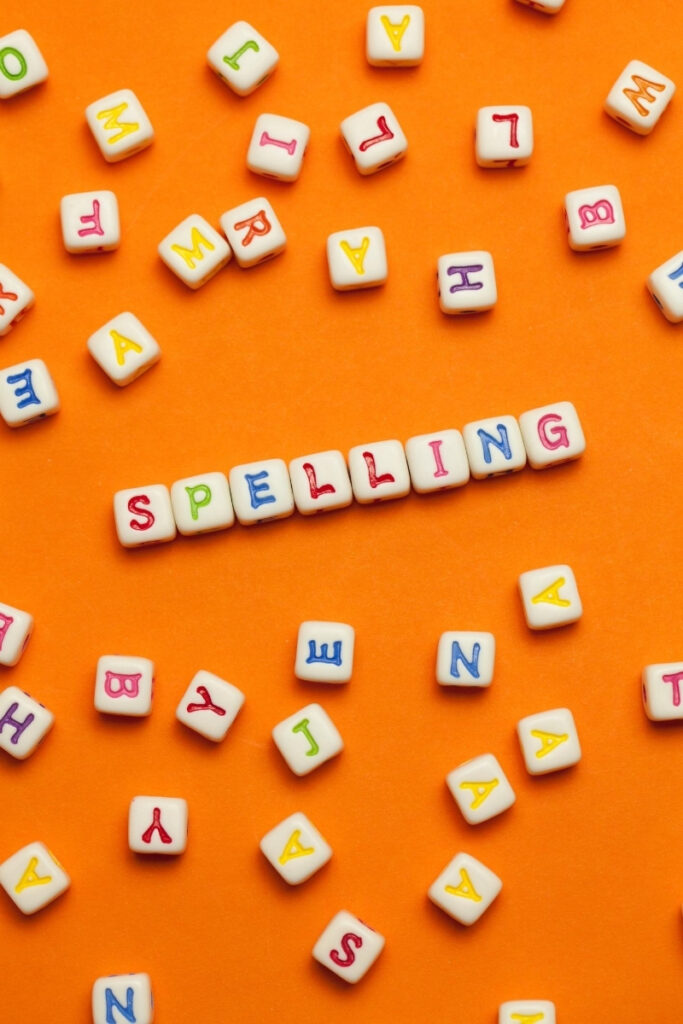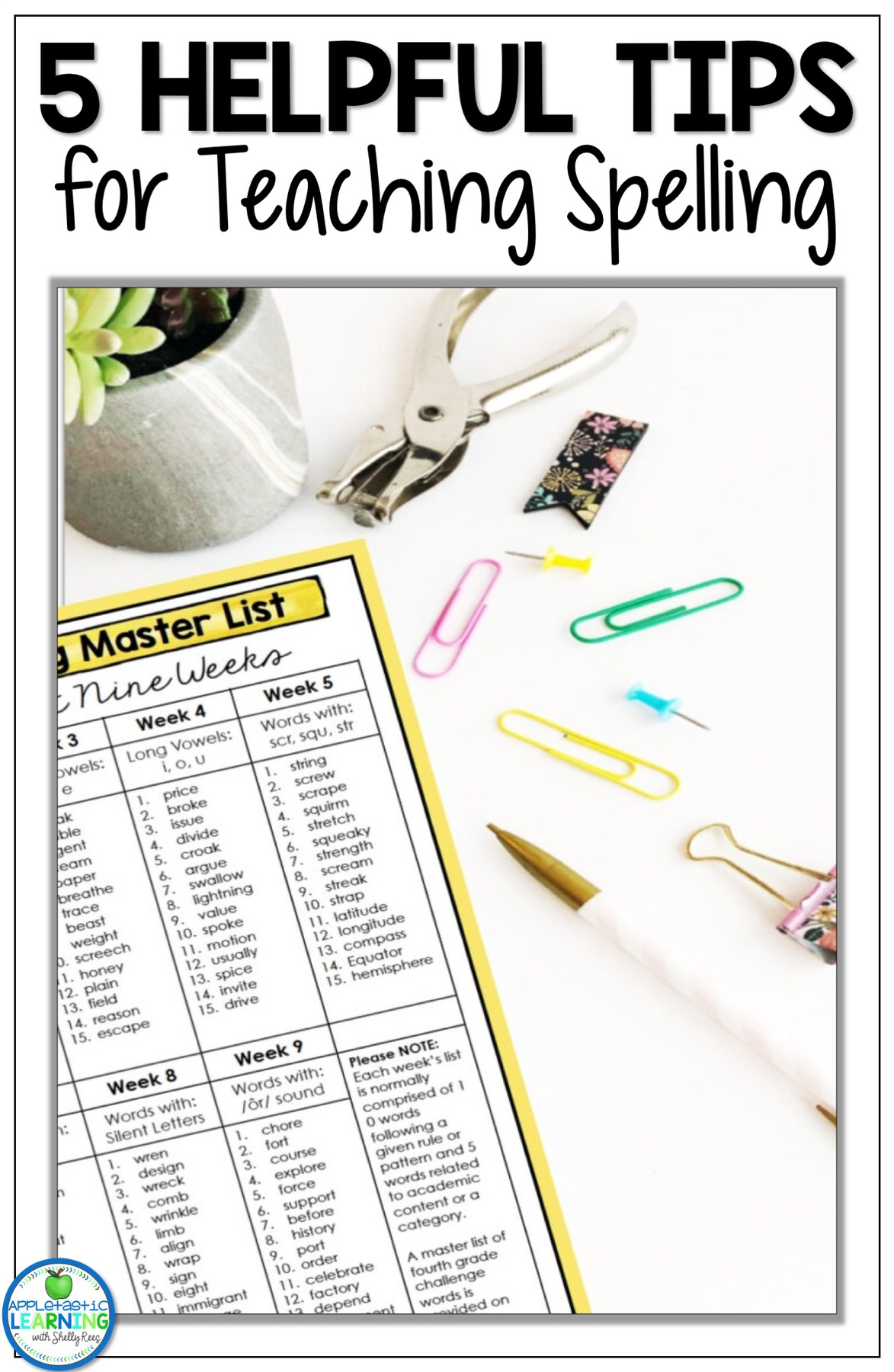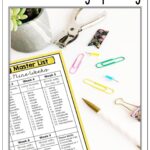

Teaching the English language is tough! There are rules and then exceptions to the rules. And then . . . there are more exceptions to the rules. There are phonetic sounds and then 6 different spelling patterns to make the same sound. It’s no wonder students groan when it’s time for spelling. But teaching spelling doesn’t have to make you groan. In fact, it doesn’t have to be hard either. Here’s 5 tips for teaching spelling in the elementary classroom.

If looking at the two skills, reading the words would be easier than spelling them. So it is important to make sure that the spelling words you give your students are words that they can already read (or at the minimum phonics sounds and patterns they have already been taught).
Think about a traditional spelling lesson. Students are taught to say the word and then spell it using the name of the letters. However, this approach leaves out the very important reading connection. Even at the simplest of words, a short vowel word would be spelled saying a long vowel in the letter name. Not only can this be confusing but it is also one reason why students struggle with spelling.
Instead, teach students to spell using the letter sounds instead of the letter names. Since spelling is the opposite of reading, we need to teach students to break the word apart into its individual sounds and teach the corresponding spelling patterns. If we teach students to say the sounds as they write the letter we are capitalizing on their prior knowledge and the way the methodology they are already a custom to. That’s helping our students work smarter, not harder!
There is very little that we learn the very first time we are exposed to. In fact, for true learning to occur we need to get the information into our long-term memory. The problem is that this is easier said than done. Look at this diagram of the learning process:
While we are busy teaching, our students’ brains are busy processing and dumping information that is not being processed as meaningful. Ahhhhh – how can that be? Information found to be meaningful makes it into short term memory and the rest – well, it’s gone. While this is a great diagram of what happens, this next image is more of what I feel like we as teachers are up against.
I don’t know, but there’s something about the little guy throwing stuff in the fire that makes it feel a little more realistic to me.
So what does this have to do with repetition? Well, things become meaningful when we have something to connect it to in our brain. So the first time our students see or hear a new word or spelling pattern, it may not “stick” if there are no prior connections. However, the second time and third time, the connections are slowly being built. And as the new information is connected to something already in the student’s long term memory then it sticks a little more for a longer amount of time. Eventually that information gets filed in long-term memory with the other pieces of information that are similar.
The more students are exposed to something, the more connections are made, the more likely the new learning will make it to long-term memory. We need to remember this when we are teaching spelling! There is no set number of repetitions that makes this process successful. In fact, I’ve found scientific articles suggesting as few as 7 repetitions and others suggesting as many as 30 repetitions. So while we don’t have a definite answer, we do know that multiple repetitions is necessary.
Based on everything we have learned so far, I’m sure you can now see the benefit of being intentional with your spelling lists. If the brain needs repeated exposure to similar information to make connections, then creating a spelling list that does just this is vitally important. While there is nothing wrong with content based spelling lists, it is likely harder for the students to master these words. However, when create and use spelling lists based on the same spelling pattern or phonics sound, we are building in repeated exposure and allowing our students to get in the repetitions necessary for mastery.
In the early grades, I would suggest teaching spelling one sound and spelling pattern at a time. Allow students to learn it and then introduce another spelling pattern with the same sound. For upper elementary students who have had instruction on a variety of spelling patterns you can create lists based on a target sound and review multiple spelling patterns at the same time. Or, you can follow a similar approach as the early grades but with more difficult words.
Does the thought of this make you think “I know this is right, but I don’t have time”? No worries, the hard work is already for you in the Building Spelling Skills curriculum! This full year spelling curriculum includes EVERYTHING you need. Yep – everything! And it’s involves absolutely NO PREP WORK on your part. Simply print the lesson plans for the week, copy the coordinating pages and that’s it. Spelling is done!
You can find a full year of spelling curriculum for 3rd grade, 4th grade and 5th grade.
#5 Make Learning Words Fun
Remember that little guy in our students’ brains that was throwing information into the fire? Well, in order to keep him from mindlessly chunking information into the incinerator, we must get his attention. We need to do something to make him stop and take notice.
How can we do that? We need to make learning words fun and engaging. This includes in the lesson and the activities.
When introducing students to a new phonics sound or spelling pattern, think of a way to really grab the attention of your students. Make up a little song, add pictures, be silly, something more than just ” ‘I-G-H’ makes the long I sound” ” ‘er’, ‘ir’, and ‘ur’ say /er/.” Both of those statements are absolutely true, but that little guy in the brain – well he just hears Charlie Brown’s teacher saying “wah wah wah wah wah wah wah.” Burned – that ‘s what happened to that learning opportunity.
Instead try something different. How about singing this to the tune of “The Wheels on the Bus”:
‘I-G-H’ says eye, eye, eye
eye, eye, eye
eye, eye, eye
‘I-G-H’ says eye, eye, eye
the Long I sound.
When you start singing that little guy stops burning and starts listening. But I’m not saying you have to sing and dance. How about some voice inflection and a little over the top acting (don’t be afraid to be a little silly)!
Boys and girls today we are talking about the /er/ sound.
The letters ‘er’ say er.
But can I tell you a secret?
(Now whispering) So do the letters ir.
Wanna know another secret?
So do the letters ur.
(Now a little exasperated) How can this be?
‘er’, ‘ir’, and ‘ur’ all make the same sound?
Yes they do! Now I have a challenge for you.
Are you up for a challenge?
Let’s show those tricky letters that they can’t trick us.
Let’s learn how to spell words with the /er/ sound.
Just using voice changes and a little acting, and you’ve got your students attention. Better yet, you’ve got the attention of the little guy in their brain!
To keep activities fun and engaging we need to offer variety. And if doing the same activity again and again, we need to make it fun. When building the year long spelling curriculum this was a goal. Each week students will focus specific phonics sounds. This might be one sound or two or three closely related sounds. During the wee, they will complete four practice activities. But . . . not all of the activities are the same each week.
Two of the activities are consistently used week after week. Why? Because they provide a great foundation giving students repetition and connections. Students start the week with some repeated spelling practice and then a word meaning activity which helps them see the target word in light of its meaning rather than its spelling pattern. This helps the brain connect it to other learning about the word.
The other two activities are different every week. This means students are not repeating an activity for over 2 months. That keeps the activities fresh and fun. While all the activities are designed to help students learn the words, the activities never gets boring or stale. I don’t know about you, but growing up we did the same spelling activities every.single.week. It was chore and a bore!
You can try out 2 weeks of the Building Spelling Skills program for free. Grab your free sample and see if teaching spelling becomes easier for you and effective for your students.
Or, grab the full curriculum and have your spelling lessons and planning DONE for the entire school year!


Hi, I’m Shelly! Thank you for being here. I love helping third, fourth, and fifth grade teachers with fun and engaging activities that require no to little prep! Let me help you by taking some of the stress and work off your plate.

©2022 Shelly Rees. All Rights Reserved.
